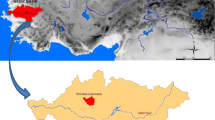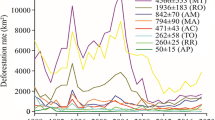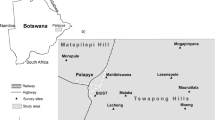Abstract
The aim of this study was to produce a land productivity dynamic map of a degraded catchment located in dryland ecosystem via a land degradation assessment using three indicators, namely land use, land productivity, and soil organic carbon density. The study was conducted in the Mogan Catchment, Turkey, between 2000 and 2010. The study embraced the current trend for assessing ecosystem services over wide areas. For this purpose, satellite images were used to determine changes in land use and vegetation density. In addition, a total of 834 soil samples were collected from the surface soil in 2000 and 2010 to assess the soil organic carbon density. In more than 37% of the catchment area of approx. 37,100 ha, land productivity had declined, while about 43% of the catchment showed early signs of decline. Analysis of long-term changes and the conversion of levels of vegetative or standing biomass into land productivity dynamics (LPD) is only the first step. Current land management practices are contributing to serious, widespread land degradation, with only a very small area of the catchment showing a stable or increasing LPD for the period from 2000 to 2010. The implementation of land management policies and practices in order to achieve sustainable land management are urgently required.










Similar content being viewed by others
References
Blake, G. R., & Hartge, K. H. (1986). Bulk density. In A. Klute (Ed.), Methods of soil analysis. Part 1.Physical and mineralogical methods, Agronomy (Vol. 9, 2nd ed., pp. 363–382).
Bonneau, L. R., Shields, K. S., & Civco, D. L. (1999). Using satellite images to classify and analyze the health of hemlock forests infested by the hemlock woolly adelgid. Biological Invasions, 1, 255–267.
Braun-Blanquet, J. (1964). Plant sociology: the study of plant communities (3rd ed.). Berlin-Wien-New York: Springer-Verlag.
Cherlet, M., Ivits, E., Sommer, S., Toyh, G., Jones, A., Montanaraella, L., & Belward, A. (2013). Land-productivity dynamics in Europe. Towards valuation of land degradation in the EU (p. 61). JRC Scientific and policy Reports.
Congalton, R. G. (1996). Accuracy assessment: a critical component of land cover mapping. In J.m. Scott, T. H. Tear, & F. Davis (Eds.), A landscape approach to biodiversity planning Charlotte, North Carolina (pp. 119–131). American Society of Photogrammetric and Remote Sensing.
Congalton, R. G., & Oderwal, R. G. (1983). Assessing Landsat classification accuracy using discrete multivariate analysis statistical technique. Photogrammetric Engineering and Remote Sensing, 49, 1671–1678.
Demirel, H., Ozcinar, C., & Anbarjafari, G. (2010). Satellite image contrast enhancement using discrete wavelet transform and singular value decomposition. IEEE Geosciences and remote sensing letters, 7, 333–337.
DMI. (2010). Turkish State Meteorological Service. Turkey: Ankara.
Doğan, H. M., Kılıç, O. M., & Yılmaz, D. S. (2014). Researching plant density classes of Tokat Province by Landsat-7 ETM+ satellite image and GIS. Journal of Agricultural Faculty of Gaziosmanpasa University, 31(1), 47–53.
Edwards, M. C., Wellens, J., & Al-Eısawı, D. (1999). Monitoring the grazing resources of the Badia region, Jordan, using remote sensing. Applied Geography, 19, 385–398.
ERDAS. (2003). Erdas Field Guide (7th ed.). Leica Geosystems, GIS and Mapping LLC: Atlanta, Georgia.
Eswaran, H., Lal, R., & Reich, P. F. (2001). Land degradation: an overview. Proc.2nd. International conference on land degradation and desertification. New Delhi: Oxford Press.
Fan, F., Weng, Q., & Wang, Y. (2007). Land use/land cover change in Guangzhou, China, from 1998 to 2003, based on Landsat TM/ETM+ imagery. Sensors, 7, 1323–1342.
Forkuo, E. K., & Frimpong, A. (2012). Analysis of forest cover change detection. International Journal of Remote Sensing Applications, 2(4), 82–92.
Hill J (2003) Land and soil degradation assessments in Mediterranean Europe. The GMES-Project LADAMER. Contribution to the GMES Full Details Report, pp. 69
Jones, R. J. A., & Montanarella, L. (2003). Land degradation. The JRC enlargement action. In Contributions to the International Workshop “Land degradation” 5–6 December 2002, Ispra, Italy (p. 333). Italy: Soil and Waste Unit Institute for Environment & Sustainability Joint Research Centre European Commission Ispra, 21020.
Kosmas, C., Kirkby, M., & Geeson, N. (1999). The Medalus project Mediterranean desertification and land use (p. 94). Luxembourg: European Commission Community Research Project Report. Office for Official Pubolications of the European Communities.
Lal R, Safriel U, Boer B (2012) Zero net land degradation, a new sustainable development goal for RIO+20; a report prepared for the Secretariat of the UNCCD, May 2012
Moller-Jensen, L. (1997). Classification of urban land cover based on expert systems, object models and texture. Computers. Environment and Urban Systems, 21, 291–302.
Nelson, D. W., & Sommers, L. E. (1982). Total carbon, organic carbon and organic matter. In L. A. Page, R. H. Miller, & D. R. Keeney (Eds.), Methods of soil analysis, part 2. Chemical and microbiological methods (2nded ed., pp. 539–579). Madison, Wisconsin: American Society of Agronomy.
Pla, I. (2008). Desertification under climate change and chancing land use in Mediterranean environment. In D. Gabriels, W. Cornelis, M. Eyletters, & P. Hollebosh (Eds.), Combating desertification assessment, adaptation and mitigation strategies (pp. 30–40). Belgium: Published jointly by UNECO Chair of Eremology, Ghent University.
Puigdefabregas J (2011) DESURVEY: a surveillance system for assessing and monitoring of desertification. European Commission 6th Framework Programme: Global Change & Ecosystems. Integrated Project Contract No. 003950. Publishable Final Activity Report, pp. 23
Retiere, A., Sommer, S., Minelli, S., Byron-Cox, R., & Candelori, M. (2015). Land degradation neutrality from concept to practice. In Using the UNCCD indicator framework to set LDN national voluntary targets and monitor their achievement. Methodological note (p. 13). Italy: Joint Research Center.
Sample L (2007) Global food crisis loams as climate change and population growth strip fertile land. The Guardian. Retrieved 2008–07-23
Sommer, S., Zucca, C., Grainger, A., Cherlet, M., Zougmore, R., Sokona, Y., Hill, J., Della Peruta, R., Roehrig, J., & Wang, G. (2011). Application of indicator systems for monitoring and assessment of desertification from national to global scales. Land Degrad Develop., 22, 184–197.
UNCCD (2013) A stronger UNCCD for a land-degradation neutral world, Issue Brief, Bonn, Germany, pp. 20
UNCCD (2016) United Nations Convention to combat desertification. The Global Mechanism. Land degradation neutrality: the target setting programme. Bonn, Germany, pp 22
Vieira, S. R., Nielsen, D. R., & Biggar, J. W. (1981). Spatial variability of field-measured infiltration rate. Soil Science Society of America Journal, 47, 175–184.
Von Braun, J., Gerber, N., Mirzabaev, A., & Nkonya, E. (2012). The economics of land degradation (p. 41). Berlin: An Issue Paper for the First Global Soil Week.
Wickware, G. M., & Howarth, P. J. (1981). Change detection in the Peace-Athabasca delta using digital Landsat data. Remote Sensing of Environment, 1, 9–25.
Woo, D. M., & Do, V. D. (2015). Post-classification change detection of high resolution satellite images using AdaBoost classifier. Advanced Science and Technology Letters., 117, 34–38.
Yagbasan, O., & Yazicigil, H. (2009). Sustainable management of Mogan and Eymir Lakes in Central Turkey. Environmental Geology, 56, 1029–1040.
Acknowledgements
The authors thank the General Directorate for the Protection of Special Areas and General Directorate of Rural Services (Project no: 2000-TG018) and General Directorate of Agricultural Research and Policies (TAGEM) in Ankara, Turkey, for funding this project. In addition, the authors thank Gregory T. Sullivan for editing the English in an earlier version of this manuscript.
Author information
Authors and Affiliations
Corresponding author
Rights and permissions
About this article
Cite this article
Baskan, O., Dengiz, O. & Demirag, İ.T. The land productivity dynamics trend as a tool for land degradation assessment in a dryland ecosystem. Environ Monit Assess 189, 212 (2017). https://doi.org/10.1007/s10661-017-5909-3
Received:
Accepted:
Published:
DOI: https://doi.org/10.1007/s10661-017-5909-3




